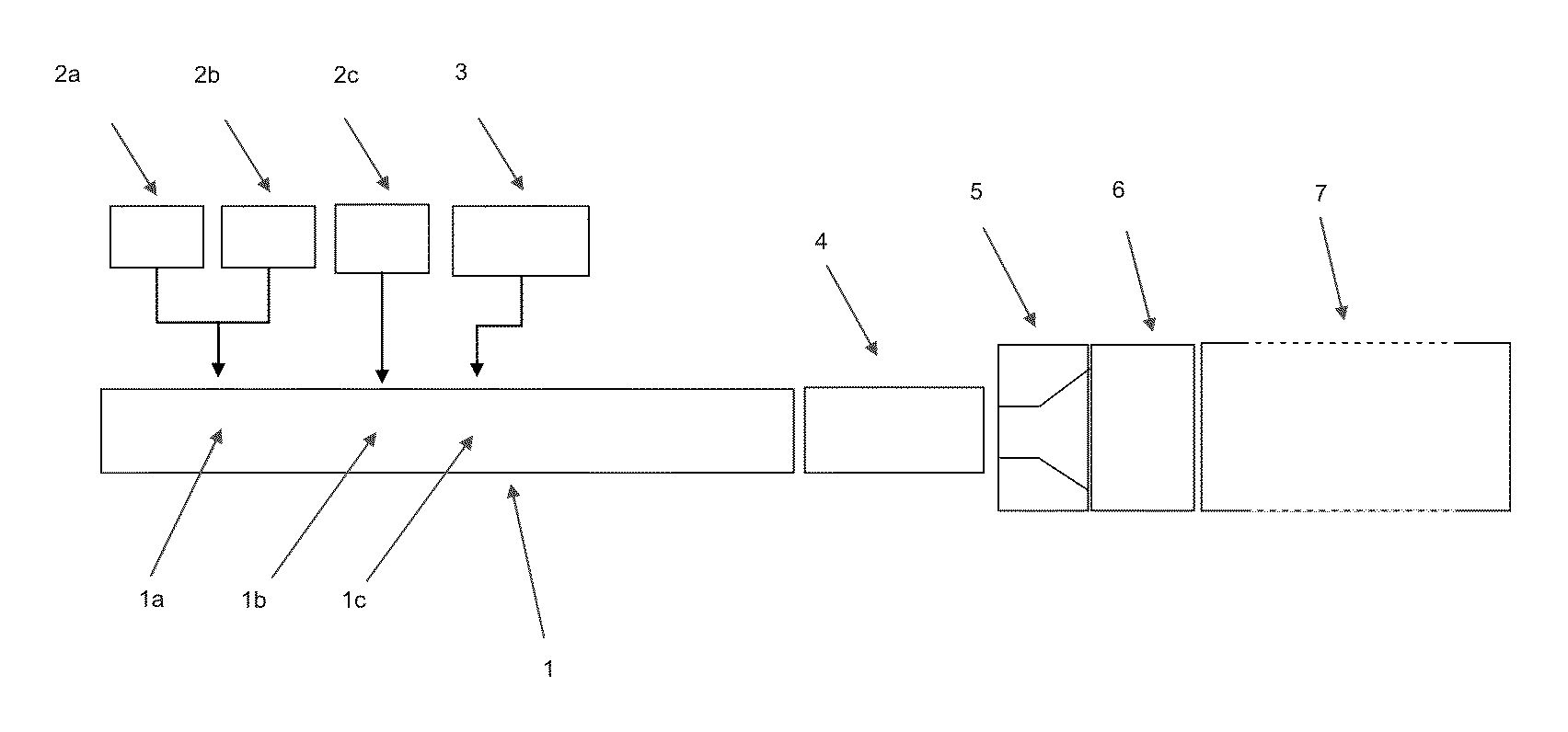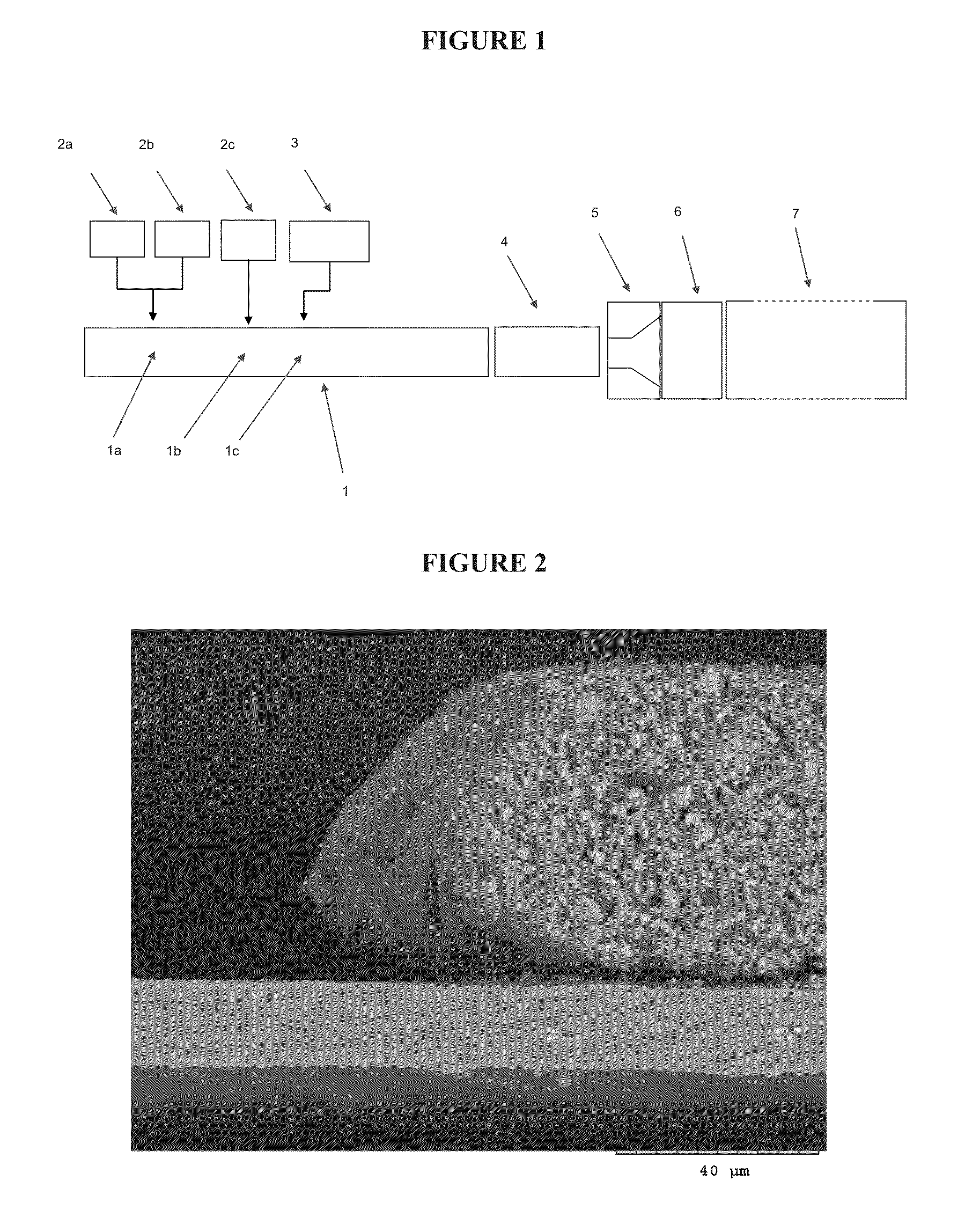Method for preparing a positive electrode material through extrusion in presence of an aqueous solvent, positive electrode obtained through said method, and uses thereof
a positive electrode material and solvent-based technology, which is applied in the direction of electrode manufacturing process, cell components, electrochemical generators, etc., can solve the problems of increasing the time required for drying step, limiting the content of active electrode materials that it is possible to incorporate, and not being able to incorporate lithium salts into this solution, so as to prevent degradation of active iron-phosphate-based materials, stabilize the final width, and reduce the residence time of water in the composite
- Summary
- Abstract
- Description
- Claims
- Application Information
AI Technical Summary
Benefits of technology
Problems solved by technology
Method used
Image
Examples
example 1
Preparation of a Positive Electrode According to the Process of the Invention
[0086]In this example, a positive electrode was produced with the process according to the invention, at a feed rate of 10 kg / h, using a corotating twin-screw extruder equipped with a number of weigh feeders one of which was connected to a side feeder, a liquid injection pump, a rework single-screw extruder coupled to a flat die, a unit for rolling the electrode onto a current collector and a drying tunnel.
[0087]The arrangement used is shown in annexed FIG. 1 in which a twin-screw extruder (1) 1.1 meters in length, comprising 10 zones and having a diameter of 25 mm is supplied with solid ingredients by weigh feeders (2a, 2b, 2c) and with aqueous solvent (demineralized water+LiTFSI) by a liquid, injection pump (3), the extruder (1) is coupled to a rework single-screw extruder (4) having a diameter of 30 mm, itself equipped with a flat die (5), opening onto a rolling station (6) and ending in a forced-convect...
example 2
Preparation of a Positive Electrode According to the Process of the Invention
[0094]In this example, a positive electrode was produced with the process according to the invention, at a feed rate of 100 kg / h, using a corotating twin-screw extruder equipped with a number of weigh feeders one of which was connected to a side feeder, a liquid injection pump, a rework single-screw extruder coupled to a flat die, a unit for rolling the electrode onto a current collector and a drying tunnel.
[0095]The arrangement used is similar to that of example 1.
[0096]The positive electrode was prepared by introducing a poly(ethylene oxide) / poly(butylene oxide) copolymer in the form of granules, sold under the trade name HQSEB by Dai-Ichi Kogyo Seiyaku (DKS), into the feeder (2a), introducing high-specific-surface-area carbon particles sold under the trade name Ketjen Black EC-600 H) by AkzoNobel into the feeder (2b), and introducing LiFePO4 particles into the feeder (2c) connected to the side feeder. Th...
example 3
Preparation of a Lithium Battery
[0102]In this example a lithium battery was produced containing:[0103]the positive electrode manufactured in example 2 above;[0104]an electrolyte consisting of a bilayer film as described in patent application FR-A-2 881 275, i.e. a film consisting of a first 10 μm-thick film in contact with the cathode and containing, by weight, 38% of polyoxyethylene (POE), 53% of PVDF / HFP, 9% of LiTFSI and a second 10 μm-thick film in contact with the lithium and containing 70% of POE, 22% of PVDF / FIFP, 17.8% of LiTFSi and 10% of MgO;[0105]a lithium film having a thickness of 70 μm, as a negative electrode; and[0106]an aluminum current collector.
[0107]Winding was used to join these elements.
[0108]The battery was made to operate in a C / 2 discharge regime and a C / 4 charge regime, by applying a voltage of between 3.6 V and 2.5 V to its terminals.
[0109]The voltage=f(capacity) charts obtained. (not shown) were normal and showed no process-related defects.
[0110]The lifet...
PUM
| Property | Measurement | Unit |
|---|---|---|
| thickness | aaaaa | aaaaa |
| temperature | aaaaa | aaaaa |
| temperature | aaaaa | aaaaa |
Abstract
Description
Claims
Application Information
 Login to View More
Login to View More - R&D
- Intellectual Property
- Life Sciences
- Materials
- Tech Scout
- Unparalleled Data Quality
- Higher Quality Content
- 60% Fewer Hallucinations
Browse by: Latest US Patents, China's latest patents, Technical Efficacy Thesaurus, Application Domain, Technology Topic, Popular Technical Reports.
© 2025 PatSnap. All rights reserved.Legal|Privacy policy|Modern Slavery Act Transparency Statement|Sitemap|About US| Contact US: help@patsnap.com


